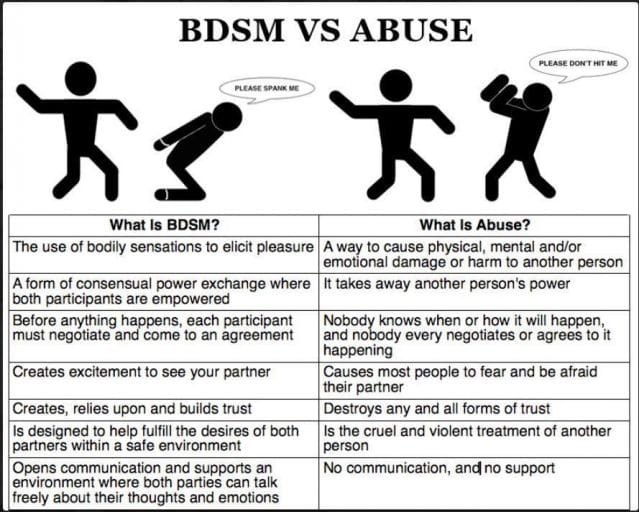|
Robert James King, Ph.D., is a researcher at the School of Applied Psychology, University College Cork, in Ireland. He has published in the field of human sexual behaviour, as well as other topics. You can follow him at @DrRobertKing Here, Robert analyses the methodology behind a research paper that claimed women were more likely to abused if they had read E.L. James' novel 50 Shades of Grey, and draws clear delineation between abuse and BDSM. A paper (Bonomi et al., 2014) surveyed women who have read one or more of the Fifty Shades of Grey series are, the authors claim, more likely to be abused by their partners and to show hatred of themselves by risky sexual activity, binge drinking, and eating disorders. And the authors claim a dose-to-effect relation. The more of the filthy stuff you read—the worse it gets! By the time you have ploughed your way through to the end of the turgid three-volume series you are an emotional and physical wreck. Scary stuff. It’s like every hackneyed episode of CSI where those that have kinky sex are punished for their perversion by ending up as forensically interesting corpses. Is it true though? A wise man once told me “The abstract giveth and the methodology taketh away”. What, actually have the authors found? They surveyed 655 college females and divided them into groups. Those who had read the first book in the FSOG series, those who had read all of them, and those who had read none of them. Then they asked questions about various forms of abuse—both self and at the hands of another. Self-Harm Let’s start with the so-called eating disorders. What was actually measured? Two things. Q1 “Have you ever fasted for a day (or more)?” and Q2 “Have you ever used diet aids?” That’s the lot. No. Calling the use of diet aids an eating disorder is just scare-mongering. These people didn’t have eating disorders—at least not that we know of. I could have got the same results by dividing the group into “gym members” and “non-gym members” The binge-drinking measure (“Having 5 or more drinks on 6 or more days in the last month”) was technically correct. For doctors, five or more drinks is a binge. For most of us—it’s a quiet night in—but let’s pass over that one to the juicy stuff, “risky sexual practices”. The criteria the authors use for prevalence of risky sexual practices were two: Q1: “Have you had five or more sexual partners?” Q2: “Have you ever had anal sex?” Really? Boy, you young people! These are the criteria for risky sexuality? I can only hope and pray that my dear sweet gray-haired mum is not reading this filth. She would laughher head off. Partner Abuse The authors failed to ask a rather pertinent question, “Do you have a sexual partner?” Or, even “Have you ever had a sexual partner?” But let’s leave that glaring omission—which itself could explain all the results—aside for the moment. In the case of the genuinely worrying behaviors—like ever having had a partner hit you, call you names, or stalk you—those who had read all three books were actually less likely to have had these things happen than those who had read one book in the series.(2) The authors do not draw attention to their own numbers that seem to show that on a number of measures reading more of FSOG makes you less likely to be abused. Why not? What’s Gone Wrong Here? Running a bunch of correlations without having any controls is a thing that we scientists call (and stop me if I’m getting too technical here) “Not doing science”. Let’s say I have a hunch that there is a nefarious plot that links people who have been killed by falling out of bed and the number of lawyers in Puerto Rico. It correlates .96 over twelve years—I bet you didn’t know that. Well, how could you? It’s a plot by Puerto-Rican Lawyers…  Well, I can search around for some correlations—but all this really tells the world is that I am obsessed with Puerto Rican lawyers (for some reason). (3) That’s why scientists control for certain factors. Here are some possible ones that don’t seem to have occurred to the authors: Did their sample read other books? Other erotic books? Do they even have sexual partners? Have they ever had sex at all? Here’s the thing—if you build in your assumptions at the start (that kink is bad) then maybe you can find a correlation there. Without controls all the authors have done is import their moralising and attached some numbers to it (4). Tellingly, they didn’t survey the 60 women who picked up the book (interested in kink, perhaps?) and then abandoned it (because it’s crap, probably). Could it be—because those people combined a healthy interest in kink with a healthy interest in better written kink? I think we should be told. Won’t Somebody Please Think of the Children? I have had some remarkably po-faced discussions with people who have solemnly informed me that FSOG is not a good example of a BDSM relationship. And you know what? They are right. It isn’t. It’s a fantasy. You know something else? Hogwarts would very likely fail an Ofsted inspection. But don’t let’s stop there. The Story of O—which is actually well written—is a terrible depiction of a BDSM relationship (5). Really. (Spolier alert!) If your partner wants you to dress up as an owl and allows you to commit suicide then then really are not paying you the care and attention you deserve. In case this is not obvious let me spell this out--do not dress as an owl and commit suicide. Venus in Furs—also a work of genuine erotic art—is also a pretty poor model for a relationship where mummy and daddy love each other very much, but occasionally do a bit of corporal punishment (6). And if you are going to base your relationships around De Sade’s Last 120 Days of Sodom…then I really don’t want to be your neighbor (7). Don’t Do It in the Street and Frighten the Horses There is something psychologically interesting about the fact that each generation finds new ways to deny female sexual agency. White slavery, coy females, and lying back and thinking of England are concepts we laugh at now. There have been eras where women had to eat bananas in private clubs because of the effect this might have if they did it publicly. Well—some women like kinky sex and the modern moral mavens had better get used to it.  There is a good reason why the various paraphilias have been removed from the diagnostic manual of mental illness—unless their desires and activities cause actual distress to the person themselves. Causing distress to onlookers? Well—don’t look on. On a range of measures kinky folk have better mental health than the vanilla population (8). The Fifty Shades Effect—Getting Your Kink On Rachel Venning, co-founder of Babeland sex shops catering mainly to women said she saw a jump in kinky item sales following FSOG. "Every person on every airplane and every beach chair was reading a copy of that book. That gave people a little more permission to explore that stuff without making them feel like a freak or weirdo," (9) A large proportion of the population are kinky (10). And, a great deal of this kink can be analysed in terms of semi-ritualised hierarchical play (11). Bondage, dominance, sadism, and masochism (BDSM). As Dan Savage puts it; “It’s cops and robbers for adults with their pants off” (12). Denying this aspect of human nature could well lead to someone with a kinky orientation mistaking certain forms of abusive behavior for their kink. So here is a handy guide for the perplexed: The conflation of what BDSM practitioners and abusers do is dangerous and false. It is also demonstrably, forensically wrong. So, as a further public service, here are some things about BDSM clubs that you might not know: 1)They are typically matriarchies. Women rule the roost—and this is true of swingers clubs too. Women are in short supply and any man who makes any woman feel remotely uncomfortable will be shown the door. No appeal. The other men have a strong vested interest in the women there being comfortable and happy. Anyone who threatens this is out. 2) Submissives are in charge. Submissives call the shots. They set their limits, often long prior to events, and they dictate what sort of things they want to explore and what things they do not. Anyone who doesn’t respect limits is likewise, out. 3) Reputations matter. People know each other and information travels fast. Anyone who gets a bad reputation will be ostracised and won’t have anyone to play with. Abusers can only exist in places where reputations don’t matter. 4) Hurting someone in any way other than that desired (by them) is very bad form. I once saw a very experienced and sought-after dominant guy doing an elaborate scene involving suspension and all sorts of arcane activity with scary-looking violet wands. His partner—who was in an almost trance-like sub-space state--got a cramp. She was got down quickly but her dom partner was utterly mortified that he hadn’t anticipated it. I have rarely seen someone so embarrassed. Could you get someone who genuinely wants to hurt women at a BDSM club? Sure. But not for long. They are going to be bored—because what they want is to really hurt someone and all they are going to get is fantasy. Consensual fantasy. If you go to a BDSM club you will see a care and attention lavished on submissives that vanilla folk could learn some lessons from. I certainly did. References 1) Bonomi A, Nemeth J, Altenburger L, Anderson M, Snyder A, Dotto I. Fiction or Not? Fifty Shades is Associated with Health Risks in Adolescent and Young Adult Females. Journal of Women’s Health. 2014. http://online.liebertpub.com/doi/full/10.1089/jwh.2014.4782 2) The figures given were respectively 14.1% compared to 7 %, 37.7% compared to 38% and 30.2% compared to 41.3%, Respectively. Bonomi et al, 2014 Table 3 3) http://www.tylervigen.com/about http://tylervigen.com/view_correlation?id=28592 Lawyers and Puerto Rico 4) http://4.bp.blogspot.com/-7TtVzvIhT2s/TlumZzSZ_CI/AAAAAAAAAO0/WbI30DJAURg/s1600/canary+in+coal+mine.gif 5) Story of O (1954) Pauline Reage 6) von Sacher-Masoch, L. R. (2000). Venus in furs. Penguin. 7) De Sade, M. (2007). The 120 days of Sodom and other writings. Grove/Atlantic, Inc.. 8) Wismeijer, A. A., & Assen, M. A. (2013). Psychological characteristics of BDSM practitioners. The journal of sexual medicine, 10(8), 1943-1952. http://onlinelibrary.wiley.com/doi/10.1111/jsm.12192/abstract;jsessionid=20EAEE3487F3C70BF32276D4C54A0564.f01t01 9)http://www.reuters.com/article/2013/05/31/us-bdsm-practitioners-idUSBRE94U17J20130531 10) Jozifkova,E. & Flegr,J. Dominance, submissivity (and homosexuality) in general population. Testing of evolutionary hypothesis of sadomasochism by internet-trap-method. Neuroendocrinology Letters 27, 711-718 (2006) 11) Jozifkova,E. & Konvicka,M. Sexual Arousal by Higher- and Lower-Ranking Partner: Manifestation of a Mating Strategy? Journal of Sexual Medicine 6, 3327-3334 (2009) 12) http://www.savagelovecast.com/ For the forensic differences between abuse and S&M check out this excellent piece by Donnie Rice--which deserves wide circulation http://ow.ly/AHliv This article was originally published at https://my.psychologytoday.com/blog/hive-mind/201408/fifty-shades-nay and has been published here with the author's kind permission
0 Comments
Leave a Reply. |
Sex
|

 RSS Feed
RSS Feed